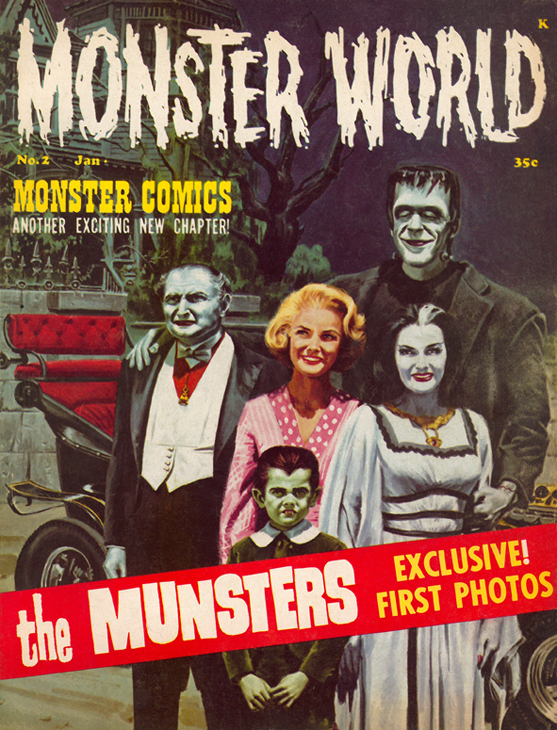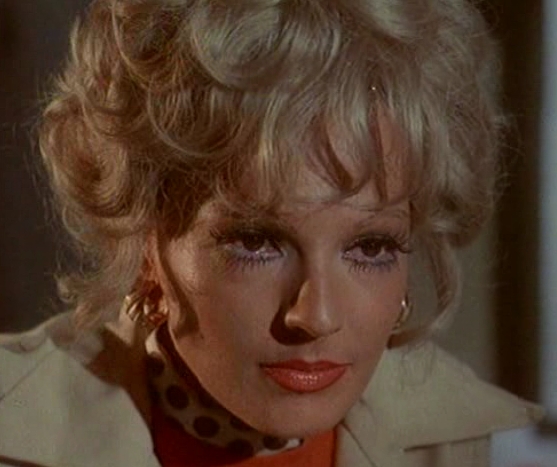
In its early days, television was live. Variety programs were beamed directly to your home like electronic vaudeville, and drama was acted out as you watched, literal live theater in your living room, with all of its exhilarating immediacy and its inevitable flubs and miscues.
There are countless stories of live TV gaffes from the early days. Actors blew their lines, sets collapsed and props malfunctioned right before your eyes. Even the commercials were live. I remember, as a kid, seeing someone faint on camera, a pitchwoman who delivered a few lines in a trembling voice before her eyes rolled back and she slipped out of frame.
Of all the famous blunders of classic TV, one of — if not THE — most often referenced (usually by people who’ve never actually seen the episode) is Lon Chaney’s reputedly drunken performance as Frankenstein’s Monster on Tales of Tomorrow, in 1952. With the storied episode now freely available on the internet, we are able to view the broadcast and evaluate it for ourselves.

In 1951, the fledgling ABC network launched Tales of Tomorrow, the first serious science fiction anthology series, a welcome, grown-up alternative to Captain Video and Tom Corbett Space Cadet who navigated the spaceways in their plywood rockets, bringing raygun justice to studio-bound alien worlds. Tales of Tomorrow predated The Twilight Zone, which would mine the same fertile field. Star Trek’s Gene Roddenberry cited Tales of Tomorrow as an early influence.
The series lasted two seasons, yielding an amazing 85 episodes. The casting was impressive, with established movie stars the likes of Joanne Woodward, Randolph Scott and Veronica Lake putting in appearances. Boris Karloff showed up twice. Rod Steiger and James Dean shared a show in full method mode, stepping on each other’s lines. A young Paul Newman clocked his first screen appearance.
Some of the best SF writers of the time contributed stories and scripts. Theodore Sturgeon wrote the very first episode. Even classics by Jules Verne and H.G.Wells were adapted for the show, to be compressed and simplified into brief, thirty-minute playlets acted out on minimal sets.

At its best, the show delivered tense cautionary tales of nuclear peril and other Cold War fears. On January 18, 1952, with its sixteenth episode, Tales of Tomorrow staged a freewheeling adaptation of what has been called the first science fiction novel, the original, seminal story of technology run amok, Mary Shelley’s Frankenstein.
Writer Henry Myers came with solid screenplay credits including The Black Room (1935), and the western classic Destry Rides Again (1939). His interpretation of Frankenstein was superficially inspired by movie versions of the story. One wonders if he bothered reading the original novel. There’s nothing here of Mary Shelley’s, except perhaps for the little boy, Frankenstein’s nephew, William, who will be menaced by The Monster.
Director Don Medford was the series’ anchor, handling over 70 episodes. Medford went on to a fabulous television career, directing such popular titles as Dynasty, M Squad, Invaders, Man from Uncle and Baretta, eventually totaling over 600 hours worth of television drama. His handling of Frankenstein is workmanlike, with a few imaginative touches. When The Monster escapes from the lab, the camera follows Chaney through a door and down a long corridor, lines painted on the floor creating deep perspective, bringing a sudden impression of depth to an otherwise two-dimensional stage. The creation scene is livened with an overhead view, the camera simply shooting up into a mirror. In a scene where The Monster goes into a murderous rage, Chaney is made to rush the camera, grimacing, the gruesome stitched makeup in extreme, unsettling closeup.

John Newland, the restrained actor cast as Victor Frankenstein, would go on to a busy career as a TV director, contributing to Alfred Hitchcock Presents, Wonder Woman and Thriller, notably the Pigeons From Hell episode.
The trump card for the show was the casting of Lon Chaney, the famous monster movie actor, in the role of Frankenstein’s Monster. It would be Chaney’s second pass at the role, having been the first man to step into Boris Karloff’s weighted boots in Ghost of Frankenstein, ten years earlier, in 1942.
The story guns along at a fair clip, logic never intruding. John Newland plays a rather distant and debonair, ascot-wearing Victor Frankenstein. He lives in a foreboding 16th Century castle on some remote, unidentified island with his kid nephew, attended by a butler and a maid. Everything we need to know is quickly exposed in the opening dinner scene with visitors Elizabeth, Frankenstein’s fiancée, and her father, his former teacher. Frankenstein expresses his obsession with artificial life. Elizabeth humors him, dad is fascinated, and nephew William builds his own monster with a pineapple body, banana arms and olives for eyes.

The guests leave and Frankenstein goes straight to work. A couple of switches are thrown, and Lon Chaney leaps up from under a sheet. The bald-headed, split-faced Monster is an inarticulate being, wheezing and grunting, and jerking around in balled-fist frustration. Frankenstein quickly calms the agitated Monster, straps him down on a slab and retires for the night.
Soon as Victor leaves, The Monster breaks his bonds and goes exploring. He terrorizes the butler and maid, then sneaks into little Williams’ room where he tries to play with the child. William reacts, screaming, “You’re aw-gly! AW-GLY!”, which is confirmed when The Monster sees his reflection in a mirror. The disconcerted Monster throws the boy down and exits.

Despite all the commotion, the maid goes back to dusting the furniture. The Monster appears and attacks her. Cut to commercial. In the next scene, Victor and the butler hover over the maid's dead body. Victor deduces that his creation must be destroyed, whereupon The Monster bursts into the room and puts a chokehold on the hapless butler. Victor distracts The Monster with fire. “Wait!” he says, waving an unintimidating sheet of burning paper with one hand, while combing his hair back with the other, “Wait! It is I whom you hate!”.
The Monster steps up on a window ledge and roars defiantly. Frankenstein pulls out a revolver and shoots The Monster four times… right in the crotch.

The Monster yells like Jerry Lewis, “Yawahahoy!”, turns and breaks through the cardboard stained glass window, falling, we are told, 200 feet to the lake.
On cue, Elizabeth and Dad turn up. Frankenstein repents and vows to fly straight, but nobody seems overly distressed by the horrific death of the maid. Moans and growls announce that The Monster has risen from the bottom of the lake and prowls the castle again. “Bullets won’t kill him!”, Frankenstein says, but figures that “Electricty gave him life, perhaps it will take it away again”. The Monster must now be lured back to the lab, and — how’s this for a bright idea — Frankenstein sends Elizabeth and little Wiliam out on the battlements as bait.
The Monster gives chase, everyone runs back to the lab. When The Monster bursts in, he stumbles into a wire trap. Smoke pots explode, Chaney does an electrical death dance and collapses. The End.

All in all, the show is a dumbed-down Frankenstein done on a cut-rate budget. It’s interesting as an artifact of early, live television, but its notoriety comes from Chaney’s bizarre behavior.
To be fair, Chaney was not given much to do except growl and wave his arms around. When he expresses childlike fascination, trying to play with the little boy, and showing desperate dismay in the mirror scene, he acquits himself well. Chaney also pulls off a couple of good, scary scenes. The sequence where he manhandles the kid is very tense, and the scene where he goes ballistic in closeup, attacking the maid, is also effective. The problem with Chaney’s performance is that he breaks character a couple of times, apparently unaware that the show is going out on live TV.
The confusion is most apparent when he’s handling large props. On a couple of occasions, Chaney gingerly handles chairs that were obviously meant to be smashed. He carries one chair across the set, puts it down and, looking at the camera, mumbles something about “saving” it. Later on, he grabs another large chair, lifts it high, then gingerly puts it down and follows up by miming the violent gesture of throwing it down. It’s obvious, at this point, that Chaney was going through the broadcast as if it was a dress rehearsal.

Chaney was known as a heavy drinker. He would tell directors to get their scenes in early because he knew he’d be plastered by midday. His drinking, his legendary roughhousing, and a penchant for outrageous practical jokes earned him a reputation as being difficult to work with. His antics had fueled a difficult relationship with his 40’s co-star Evelyn Ankers and a led to a famous run-in with her husband, actor Richard Denning. On the other hand, John Hart, who worked with Chaney in the TV series The Last of the Mohicans remembered his co-star as a gregarious, gentle and generous man.
Tales of Tomorrow was shot in New York at ABC’s studio on East 66th Street. Every week, after sets had been built, the cast would assemble on Thursday for rehearsals, and again for a final dress rehearsal on Friday afternoon. Then, the whole crew would head across Central Park for dinner at the legendary Café des Artistes on West 67th and return to the studio in time for the 9:30 broadcast. Somewhere along the way, Chaney lost track of things and went on to flub a couple of scenes in the broadcast.

Watching the show today, we can only conclude that Chaney’s antics have been wildly overstated. The whole show is done quick and dirty, and a number of mistakes can be found. Lines are flubbed here and there, and the actor playing Victor Frankenstein seems more concerned with his hair than with a rampaging Monster. I would also submit that shooting The Monster in the shorts rates as, well, a boner.
Live TV was fraught with mistakes and, without the luxury of retakes, actors would constantly improvise and fix on the go, as Chaney does, and he makes it to the end like the trooper he was. His mistakes here are obvious, but they are pretty much run of the mill glitches of the live and unpredictable TV of earlier days. Other episodes of the series had their problems. In one show, a climactic scene called for Leslie Nielsen to pick up a gun and shoot the villain. When the prop refused to fire, Nielsen threw it away, walked clear across the stage, and strangled his intended victim. In an adaptation of The Portrait of Dorian Gray (also starring John Newland) the title painting was meant to slowly ooze blood. Instead, the fake blood spurted violently into the camera lens.
Poor Lon. Very public mistakes combined with a reputation as a boozehound and the vicissitudes of a late, declining career led to scurrilous, exaggerated claims. Chaney struggles here, but it is certainly nothing like the meltdown stories that have circulated ever since.
Judge for yourself. Tales of Tomorrow’s Frankenstein makes for fascinating viewing. You can view or download the entire episode from Archive.org.
The episode’s IMDB page.
An interview with Irving Robbin, musical director who reminisces about early TV, the show, and his interest in science fiction.
An episode guide to Tales of Tomorrow.


















































